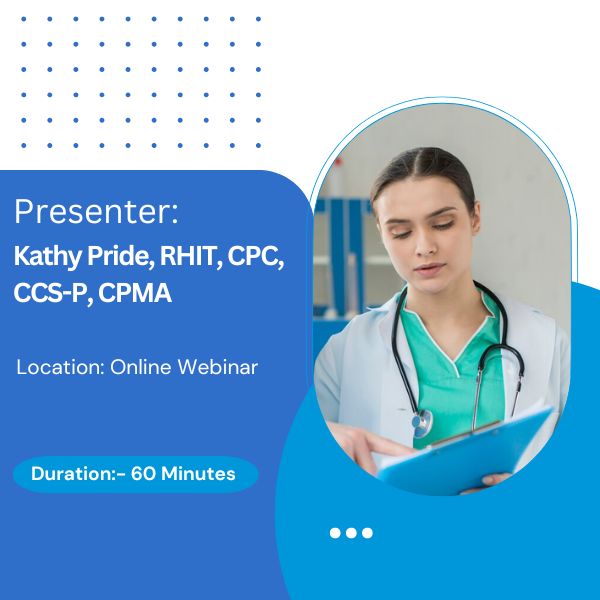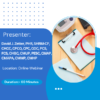Currently Empty: $0.00
In the complex world of healthcare, precise documentation is essential for the effective delivery of Evaluation and Management (E&M) services. E&M services are fundamental to patient care and are critical in determining the level of service provided during patient encounters. Concentrated and focused documentation not only supports clinical decisions but also plays a vital role in ensuring compliance with regulatory requirements, optimizing reimbursement, and enhancing overall operational efficiency. This presentation provides the importance of concise documentation in E&M services, emphasizing its impact on coding, financial outcomes, and administrative processes.
The financial aspects of healthcare are closely tied to documentation. Accurate and detailed documentation supports correct coding and billing, which is essential for appropriate reimbursement. Inaccurate or incomplete documentation can lead to undercoding or overcoding, both of which have significant financial implications.
Undercoding, where the documented level of service is lower than what was actually provided, results in reduced reimbursement and lost revenue. Conversely, overcoding, which involves billing for a higher level of service than what was documented, can lead to compliance issues and potential audits. Both scenarios highlight the necessity of precise documentation to reflect the true complexity and extent of the services rendered.
Furthermore, proper documentation aids in substantiating claims during audits and reviews. Health insurers and regulatory bodies require detailed records to verify that billed services align with the care provided. Clear and concise documentation reduces the risk of claim denials and helps resolve disputes efficiently, ensuring that the practice receives the reimbursement it is entitled to.
Effective E&M documentation minimizes the time spent on administrative tasks, allowing healthcare providers to devote more attention to patient care. By documenting only the clinically relevant information that supports the E&M service provided, practices can achieve consistency and accuracy in their documentation, reducing the need for time-consuming documentation that is not relevant to the reason for the patient visit at that encounter.
Moreover, well-organized documentation supports better workflow management. It enables healthcare staff to quickly access and review patient records, facilitating timely decision-making and reducing delays in care. Efficient documentation processes also contribute to improved practice management, as they support better tracking of patient interactions, follow-ups, and outcomes.
Adherence to regulatory requirements is a critical aspect of E&M documentation. The healthcare industry is subject to numerous guidelines and regulations, including those set forth by the Centers for Medicare & Medicaid Services (CMS) and the American Medical Association (AMA). Accurate documentation ensures compliance with the latest CPT® codes and E&M guidelines, thereby mitigating the risk of legal and financial repercussions.
Inaccurate documentation can result in compliance issues, fines, and even legal action. By maintaining thorough and precise records, healthcare providers demonstrate their commitment to regulatory standards and safeguard themselves against potential audits and penalties.
In summary, meticulous documentation in E&M services is essential for achieving excellence in patient care, optimizing financial outcomes, and enhancing operational efficiency. Accurate and comprehensive documentation supports informed clinical decisions, ensures proper reimbursement, streamlines administrative processes, and helps maintain regulatory compliance. As the healthcare landscape continues to evolve, the importance of applicable E&M documentation will remain a cornerstone of successful practice management and quality patient care. Investing in robust documentation practices not only benefits individual healthcare providers but also contributes to the overall advancement of the healthcare system.
Learning Outcomes:
- Ensure documentation accurately reflects the services rendered
- Ensure proper reimbursement for services rendered
- Enhance operational efficiency for E&M documentation and minimize administrated burden
- Identify the key documentation elements that determine the E/M level of service
- Ensure documentation supports both continuity of care and compliance with coding and billing standards
Areas Covered in the Session:
- Split and/or Shared Services
- Appropriately Split Visits with APPs with Modifier FS
- Time
- MDM (Medical Decision Making)
- Case Example – Split/Shared Billing Documentation
- Case Example – Modifier FS
- Review of Evaluation and Management (E/M) Guidelines
- Using Medical Decision Making (MDM) versus Using Time
- Selecting E/M Level of Service Using Time
- Case Example: Using Time
- E/M Documentation Update
- History
- Exam
- Medical Decision Making (MDM)
- Documenting the Level of Service Using MDM
- MDM Level
- Complexity
- Data
- Risk
- Number and Complexity of Problems Addressed
- Complexity of Problems Address at the Encounter
- Definitions of Complexity Terminology: Low
- Definitions of Complexity Terminology: Moderate
- Definitions of Complexity Terminology: High
- Amount and/or Complexity of Data to be Reviewed and Analyzed
- Category 1: Tests and Documents
- Category 2: Independent Interpretation of test
- Category 3: Discussion of management or test interpretation with external physician
- Risk of Complication and/or Morbidity or Mortality of Patient Management
- Risk of Complications of Patient Management
- Risk of Patient Complications of Management
- Moderate Risk of Complications
- High Risk of Complications
- Low MDM – Meet 2 of the 3 Elements
- Moderate MDM – Meet 2 of the 3 Elements
- High MDM – Meet 2 of the 3 Elements
- Critical Care Services
- Documentation Requirements for Critical Care Services
- Examples That Do NOT Meet Criteria for Critical Care Services
- Critical Care Services – CMS Technical Correction
- CPT Guidelines
- CMS Directives
Recommended participants:
- Healthcare Administrators
- Chief Financial Officers
- Physicians
- Advanced Non-Physician Practitioners
- Nurse Practitioners
- Physician Assistants
- Compliance Auditors
- Coders
- Billers
- Revenue Cycle Staff
- Insurance Company Claims Reviewers
Presenter Biography:

Kathy Pride, RHIT, CPC, CCS-P, CPMA, is a proven leader in healthcare revenue cycle management with over two decades of extensive experience in management, coding, billing, physician documentation improvement, compliance audits, and education. Kathy is currently the Director of Coding Solutions for Harmony Healthcare and oversees a team of expert coding compliance auditors, educators, and coding specialists. Prior to Harmony Healthcare, Kathy managed a large team of coding compliance auditors, consultants and CDI specialists providing coding compliance auditing, education, process improvement and clinical documentation improvement services to clients which included large, nationally renowned healthcare systems including the Veterans Health Administration, Critical Access Hospitals and Rural Health Clinics to small physician practices.
Additional Information:
After registration, You will receive an email with login information and handouts (presentation slides) that you can print and share with all participants at your location.
System Requirement:
- Internet Speed: Preferably above 1 MBPS
- Headset: Any decent headset and microphone which can be used to talk and hear clearly
Can’t Listen Live?
No problem. You can get access to an On-Demand webinar. Use it as a training tool at your convenience. For more information, you can reach out to the below contact: Toll-Free No: +1 800-757-9502 Email: cs@waymoreeducation.com





